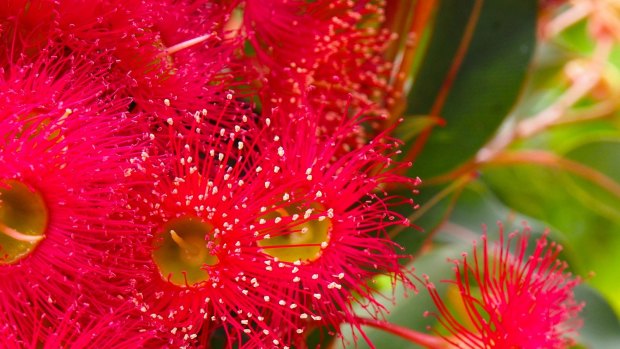This was published 8 years ago
Summer bursts with colour as cultivated flowering gums thrive in new frontiers
By Robin Powell
The flowering gums have been dazzling this summer. The massive scarlet blooms and the brilliant heads of orange beat Christmas baubles for decorative value hands down. Flowering gums make cheerily flamboyant street trees and look amazing planted with other vibrant flowers in a total colour onslaught that makes a drag queen look dowdy by comparison.
The sight of these beauties colouring our festive season is relatively recent and due to sterling work by horticulturists. First on the list of those to toast is Stan Henry. Henry was frustrated he couldn't grow Western Australia's glorious red-flowering gum in his Queensland garden. It would look as if it was growing, building tantalising anticipation, only to produce insipid flowers before dropping dead.

Flowering gum 'Summer Red'.Credit: Robin Powell
The problem was the weather. The WA native, Corymbia ficifolia, like so many other western Australian plants, is no fan of humidity. Henry's brilliant idea was to try hybridising the west Australian with one of his local swamp bloodwoods, Corymbia pthychocarpa. The successful result, now grown on grafted rootstock, is marketed as the 'Summer' series of flowering gums: 'Summer Red'; 'Summer Snow', with creamy blooms, and 'Summer Beauty', which has peachy-pink flowers.
The Summer series trees get to six metres. Recent cultivars add size options to the flowering gum menu. 'Baby Orange', for instance, is a small tree, about three by three metres, with a dense canopy completely covered through summer and into autumn by brilliant orange blooms. 'Baby Orange' and its generation of cultivars aren't hybridised but are the best selections of C. ficifolia, grafted onto a rootstock that allows them to thrive on the east coast. Siblings include 'Calypso Queen', with watermelon-pink flowers growing to a neighbour-screening four metres high and wide; and 'Lollypops' with candy-pink flowers on a tree that gets to five metres or so.
These flowering gums do best in full sun and don't like frost until they are well established. They are not needy garden plants, but to perform at their best they do require gardeners to get handy with the pruners. Tip-pruning newly-planted trees every couple of months is optional but will help develop a dense canopy. The single don't-miss job is an annual prune as the flowers start to fade. You can start this early by cutting flowers for the house - they look fantastic but don't last. The aim is to prevent the tree putting energy into producing gumnuts, which has the effect of reducing flowering the following year. You can also control the height of the tree with this prune, removing up to 30 per cent of the plant if necessary. Follow the prune with a dose of low-phosphorus fertiliser designed for natives to promote new growth and more flowering next summer.
IT'S TIME TO...
LOVE BEES
Gina Cranson is a student of natural history illustration at the University of Newcastle. She has created a poster of watercolour paintings of 21 native bees of NSW, plus two imports, to help gardeners and bee lovers ID the locals. It's beautiful as well as informative and only $20, see ginacranson.com.
TAKE CARE
If the post-Christmas lunch collapse on the lawn was marred, or scarred, by bindii prickles, make a diary note to use a bindii-specific herbicide on the blighters next winter.
PLANT OUT
Sneak alyssum seedlings into sunny gaps. This fragrant little annual copes with dry weather and poor soil and its flowers attract native and honey bees. It will self-seed readily.
DEADHEAD DAHLIAS
Keep snipping the dead flowers from bedding dahlias to promote ever more flowers.